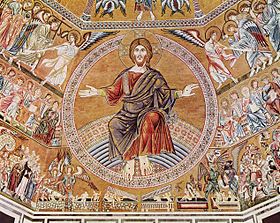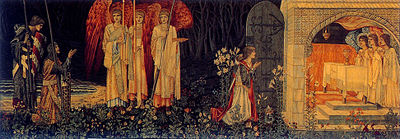‘This is the courtesy of Deep Heaven: that when you mean well, He always takes you to have meant better than you knew. It will not be enough for always. He is very jealous. But for tonight, it is enough.’
…
Before the other angels a man might sink; before this he might die, but if he lived at all he would laugh. If you had caught one breath of the air that came from him, you would have felt yourself taller than before. Kingship and power and festal pomp and courtesy shot from him as sparks fly from an anvil. The ringing of bells, the blowing of trumpets, the spreading out of banners are means used on Earth to make a faint symbol of this quality. It was like a long sunlit wave, creamy-crested and arched with emerald, that comes on nine feet tall, with roaring and with terror and unquenchable laughter.
—C. S. Lewis, That Hideous Strength
✠ ✠ ✠
If there is anything that American culture has been tragically cut off from, I think, it is courtesy. I don’t mean merely politeness; that can be found here and there even in this country—every age and nation has a mixture of civilized people and barbarians: typically the barbarians are more common, and the civilized people more wicked.
But I digress. When I speak of courtesy, I mean the exterior behavior and interior attitude proper to a royal court, the court of a king who is justly loved and admired by his subjects. And, to one another, the mutual respect and generosity of nobles who really do think highly of one another. If God is the king of creation and we are his adoptive children, even his physical relatives through the Incarnation, then we are ‘princes and princesses of the blood,’ and should think of each other as such.
I have a hunch that this is one of the gifts of the Anglican patrimony, something that the English spiritual tradition is specially good at. Each tradition has its own character: the Roman Rite and Church,1 I think, have a particular talent for simplicity, clarity, and law—which animates all the weaknesses and strengths of specifically Roman Catholicism. The straight answers to simple questions, the sparing beauty of a well-celebrated Roman Rite liturgy, the complexities of the moral life mediated through defined principles, are all expressions of the Roman spirit of obedience to the law.
The English tradition, by contrast, in both its Catholic and Anglican expressions, has been more marked by ornament and subtlety—the bold colors of the Mediterranean acquired a twilit quality in the insular north. In Mediæval England, there were a variety of liturgical forms that displayed sometimes dramatic elaborations of the simple Roman Rite: the Sarum Use,2 which was one of the main bases of Cranmer’s Book of Common Prayer, opened with a procession in which all the altars in the church were censed, concluding with a series of prayers at the rood screen in front of the sanctuary.3 Likewise, when we look at English history, on spiritual matters, there is a persistently sounded note of courtesy; Hugh of Lincoln, Lady Julian, Thomas More, Katharine of Aragon, Edmund Campion, Chesterton, Charles Williams: all have this royal graciousness, a beauty so different from the stark and militant glory of Spanish saints like John of the Cross or Ignatius de Loyola, the æthereal quality of German mystics like Tauler, or the rationalistic clarity of French Catholicism exemplified in Aquinas, Pascal, or Garrigou-Lagrange.4 The humor and tact and generosity of these English saints have a family resemblance to them that I find striking.
There are a few dimensions to this charism of courtesy that I’d like to analyze—the grammar of spiritual courtesy, if you will. These are not simply beliefs, though they involve beliefs. They are habits and attitudes, implied by and implying a whole outlook on earthly things as seen in the light of heaven. The central reality which these dimensions reveal is expressed by C. S. Lewis in part of his commentary on Charles Williams’ Arthuriana.
For the purposes of the poem it is feigned that Arthurian Britain was a province of the Byzantine empire. The whole conception of Arthur’s kingdom and the offered grace of the Grail are attributed to the Emperor. From this point of view the Emperor symbolizes God. But we must see with our imaginations why God should be so envisaged.
The image of the Empire is the final form of something that had always haunted Williams and which he often referred to simply as ‘the City.’ The word is significant. Williams was a Londoner of the Londoners. On many of us the prevailing impression made by the London streets is one of chaos; but Williams, looking on the same spectacle, saw chiefly an image—an imperfect, pathetic, heroic, and majestic image—of Order. … Such is Byzantium—Order, envisaged not as restraint nor even as a convenience but as a beauty and a splendor.
Yet order, in the sense of discipline and civility, is not the whole of what Williams sees in Byzantium: if it were, the Roman empire might have been as apt an image as the Byzantine. He chooses the Byzantine because we think of it as something more rigid, more stylized, more scrupulously hierarchical, more stiffly patterned than the Roman. Its organization suggest something geometrical; and that was what Williams desired. His great saying ‘Hell is inaccurate’ implies his outlook on heaven. He was deeply aware of Divine Order as something of a flawless and mathematical precision imposing itself on the formless flux of natural moods and passions, imposing itself in the shape of virtue, courtesy, intelligence, ritual. Sin could be defined as ‘the preference of an immediately satisfying experience to the believed pattern of the universe; one may even say to the pattern of the glory.’ … His ideal poetry is that which can ‘grow mature with pure fact.’5
It is ‘the City’ that I want to define in this series, as best I’m able. Or rather, that one of its numberless neighborhoods which is the heavenly archetype of England. Its borders seem to me to lie along certain qualities, which I shall call:
1. Precision. By this I mean an exact, disinterested attention to facts, without reference to what use we want or fear they’ll be put to.
2. Magnanimity. By this I mean thinking as well of others as we can, allowing that they may be worse than that but hoping sincerely that they’re not.
3. Irony. By this I mean being able to acknowledge the evil and the ridiculous, without letting them spoil the proper pleasures of the pure and the noble.
4. Hierarchy. By this I mean being able to accept one’s own role and those of others without resentment, embarrassment, tyranny, or slavishness.
5. Republic. By this I mean a genuine belief in the equal dignity of all men, acknowledging their hierarchical callings as roles to play.
6. Largesse. By this I mean a cheerful readiness both to give to and accept from others, rooted in hierarchy and republic alike—such that a peasant and a king could exchange Christmas gifts and each be genuinely delighted and grateful.
7. Decorum. By this I mean a particular kind of consideration for others’ feelings, that seeks not only not to injure them, but to avoid any ‘taking advantage of’ one’s position or powers.
The rest of this series will be spent fleshing out these definitions.
Lancelot came to the Canon; my household stood
around me, bearers of banners, bounteous in blood;
each at the earthen footpace ordained to be blessed and to bless,
each than I and than all lordlier and less.
The Table ascended; each in turn lordliest and least—
slave and squire, woman and wizard, poet and priest;
interchanged adoration, interdispersed prayer,
the ruddy pillar of the Infant was the passage of the porphyry stair.6
✠ ✠ ✠
1For those not familiar, a Rite of the Catholic Church is a coherent tradition of liturgy, language, and devotion. A style with a history behind it, if you will. The word Church can mean a few things in technical language: in this context, it means a self-governing Christian body with valid sacraments; I have in mind specifically those Churches that are in full communion with the Pope. This is why Roman Catholic Church, as applied to the whole Catholic communion, is kind of a misnomer. The Roman Catholic Church, strictly, is the Church of the Roman Rite (and a handful of other Rites), whose institutional head is the successor of Peter. There are others, such as the Coptic, Syro-Malabar, Byzantine Greek, Chaldæan, and Maronite Catholic Churches who are in full doctrinal agreement with and spiritual submission to the Roman Pontiff, but who are institutionally autonomous (governed by their own Patriarchs), and whose traditions are generally non-Latinate and non-Western.
2Sarum is the Latin name for the city of Salisbury in the south of England; originally, this liturgy was simply the diocesan liturgy of Salisbury, established in the eleventh century. It became common throughout England, Wales, and parts of Ireland and Scotland, until its official suppression under Queen Elizabeth I in favor of the Protestant Prayer-Book, and its less official extinction as the underground Catholics shifted to the Tridentine liturgy. The ritual of the Sarum Use, as least as interpreted by the Oxford Movement, was largely revived in the Anglo-Catholic wing of the Anglican Communion. Other English and Welsh uses included those of Bangor, York, Durham, Hereford, and Lincoln.
3In Catholic churches, the term sanctuary refers not to the building as a whole but to the area around the altar, where the Blessed Sacrament is confected and reserved (the part of the church with pews in it is the nave). A rood screen was a partition, usually of wood, that separated the sanctuary from the nave, surmounted by a crucifix flanked by figures of the Mother of God and St John; the rood screen was pierced by windows or latticework, often to the point of being more window than wall. (It is in this way quite different from the ikonostasis of the East, which normally obstructs the congregants’ view of the sanctuary and is meant to do so; the rood screen is designed to be a conceptual, more than a perceptual, partition.)
4The canny reader will have noticed that a number of these names were of alien nationality to the culture they’re identified with here: Austin of Canterbury was a Roman monk, Katharine of Aragon was Spanish, Loyola was a Basque, Aquinas came from Italy. I use them as examples of what I take to be the spirit of the pertinent culture, and of course culture is not the same thing as ethnicity or citizenship.
5Arthurian Torso: Williams and the Arthuriad, pp. 104-107. I can hardly recommend this book highly enough, and it is, of course, out of print.
6Stanzas 7 and 12 of Charles Williams’ poem Taliessin at Lancelot’s Mass. The porphyry stair is a reference to the chambers of the Emperor in Byzantium.



No comments:
Post a Comment